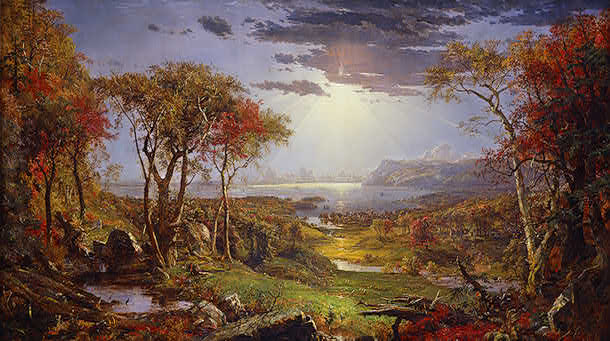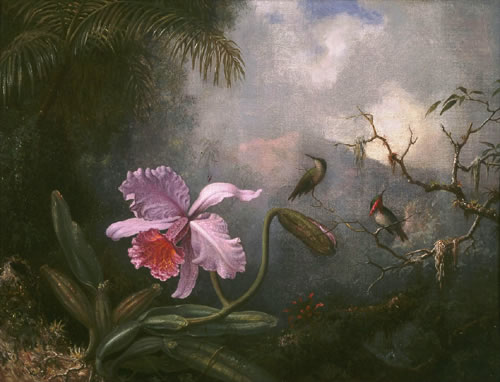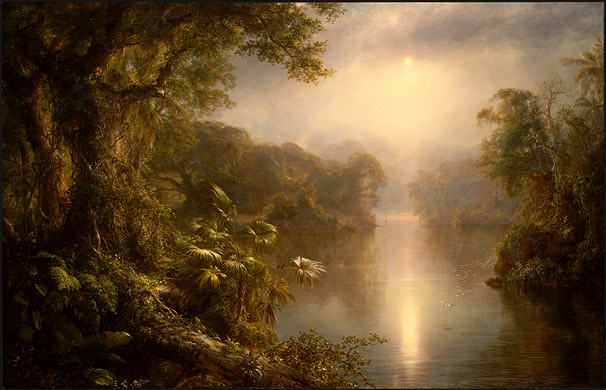My mother and brother came from Texas to visit. Looking for something touristy for us to do, I finally checked out, for the first time, the state park at Olana. A castle in detailed pseudo-Arabic style only five or six miles from my house, impressively overlooking the Hudson River lengthwise, Olana was the home and monument of Frederic E. Church (1826-1900), probably the most famous figure in the Hudson River School of painters.
The first word I heard about the Hudson Valley was sometime around seventh grade; I gathered, by an inattentive process of osmosis, that Henry Hudson explored the river named for him, and Fulton launched a steamboat here. The second time I gave the Hudson Valley a moment's thought was some 29 years later, when I was offered an interview at Bard College. Since moving here, I've always thought that at some point I would, in my usual obsessive fashion, study the Hudson River School. Now, for four days, I've been surveying paintings by some dozen or so artists in that clique. Suddenly, as I look out my window at the oak trees, tiger lilies, cumulous clouds, and Catskill mountain contours, I see them with a new shock of recognition. They are no longer simply pastoral, but dramatic, august, foreboding, emblematic of the New World with its new moral possibilities, the natural image of Democracy as crafted by God Almighty. I am living in one of the planet's most widely-painted landscapes, in the epicenter of the birth of American art. Though I didn't know it, I inhabit hallowed ground.

Cropsey: Autumn on the Hudson River
Since I am something of an involuntary historian of American music, naturally my mind turns to that artform. Where is the Hudson River School of composers? They don't exist. Church, his teacher Thomas Cole (1801-1848), Jasper Cropsey (1823-1900), Martin Johnson Heade (1819-1904), George Inness (1825-1894), even the failed portraitist and eventual inventor Samuel F. B. Morse (1791-1872), used these trees and mountains around me as a springboard for a new definition of art only tangentially related to that of Europe. The American composers of those and even later generations - George Frederick Bristow (1825-1898), John Knowles Paine (1839-1906), George Whitefield Chadwick (1854-1931), Edward MacDowell (1860-1908), Horatio Parker (1863-1919) - were not of the same stature. They did not create a new artform. Their music is a pale imitation of the European aesthetic of their day. In vain one listens to their symphonies, tone poems, piano pieces, and string quartets, for a new feeling for melody, a new sense of form, a departure from Europe. They were timid. Their emphasis was not on a bold new beginning, but on a sense of correctness, a balance learned rather than created, and a desire to impress. At their very best - as in, say, Chadwick's string quartets - one finds an energetic smoothness, but even here the music seems to plead, "Look - I followed all the rules. Isn't that enough?" Absent is any creative spark, or even the tenderness of Heade's obsessive exploration of hummingbirds and exotic orchids. Their hulking climaxes are poorly calculated, and not even their adagios seem deeply felt.
It may be - I don't know - that artists look down their noses at the Hudson River painters the way we musicians condescend to America's Romantic composers, but I don't get that impression. Like Chadwick, Paine, and Parker, the Hudson River painters studied in Europe, yet unlike them did not seem to have their individuality crushed by the experience. Church, prolific due to his inherited wealth, has his better and worse pieces, but it is not difficult to have favorites, such as his Rio de Luz, Niagara from the American Side, Icebergs, Twilight in the Wilderness. Cropsey had a flair for red-tinged canvases, and was known as "The Painter of Autumn." The veracity of his colors in an American forest in October was so doubted in England that he took up the practice of saving red leaves and exhibiting them next to his paintings to prove that he did not exaggerate. Heade's perfectly flat New Jersey horizons, more zen than even Caspar David Friedrich's paintings, have particularly appealed to the modern sensibility, and the quirky sensuality of his myriad orchids is quite lovable.

Heade: Catellya Orchid with Hummingbirds
These painters acquired a dazzling Continental polish, yet added something of their own. Unlike their Continental counterparts they omitted human figures and concentrated on nature alone, and in common they developed a remarkable approach to light that has in recent decades been christened "luminism." There are dozens of their works one can develop a soft spot for. By contrast, in all the years I have been trying to nurture a taste for the music of Chadwick, Paine, and Parker, I've never found a single work that recommended itself to me over the others. That music is listened to by specialists in American music history, and I can't vouch for any reason that it should be listened to by anyone else. It is irreparably eclipsed by even the minor works of Mendelssohn, Brahms, Dvorak. No Chadwick or Paine work I've been able to ferret out comes remotely close to matching the miracle of Church's South American sun:

Church: Rio de Luz
Insofar as one can judge from available recordings, I have only found three pre-1890 American orchestra works of any notable interest: The Ornithological Combat of Kings (1836) by Anthony Philip Heinrich (1781-1861), the Niagara Symphony (1854, though it doesn't seem to have been performed before the current decade) by William Henry Fry (1813-1864), and Night in the Tropics (1861) by Louis Moreau Gottschalk (1829-1869). All three were based on New World subject matter - South or Central America in Heinrich's and Gottschalk's cases, like so many of Church's and Heade's best paintings. All three offer effects unknown to European music of the time - particularly Gottschalk's pop-music syncopations and the rumble of eleven timpani with which Fry evokes Niagara's cascade. All three are marked by a technical ineptitude that any sensitive amateur could pinpoint - Heinrich's marching-band momentum badly needs a rest now and then, Gottschalk's harmonic rhythm is deadeningly predictable, and Fry lapses into Wagnerian banality whenever he's not being onomatapoetically athematic. They seem today like brave but Quixotic figures, would-be heroes whom the passage of time reduces to clowns. Their visual-art counterpoints are not the Hudson River School, but the untrained amateur painters like Ammi Phillips (1788-1865) and the Quaker Edward Hicks (1780-1849). Except for Gottschalk, who studied with the eccentric Berlioz rather than with academicians like Reinecke, Rheinberger, and Jadassohn, they didn't train in Europe, and their music demonstrates the extent to which energy and technical polish seem in inverse proportion in early American music.
In addition I've long nurtured a brief for George Bristow, who, unlike the other 19th-century American symphonists, didn't study in Europe. He was a violinist in the New York Philharmonic, and, for a time in the 1850s, resigned his job to protest the treatment of American composers, a move I've always admired him for. More than any other figure of that era, he seemed to search for a new feeling of solitude in the American wilderness, best captured in the opening violin solo of his "Arcadian" Symphony. But despite his successful melodic pathos, his music is overly repetitive and ultimately tedious. The earliest well-trained American composer I can listen to with pleasure is Arthur Foote (1853-1937), whose A Minor Piano Quintet has a lovely American bounce to it. The music of the admirable Amy Beach (1863-1944) I have tried hard to form an attachment to without success.
It is a telling measure of the stature of all these composers that in 1896-8 a young Charlie Ives, as an undergraduate at Yale, chafing against a composition teacher fundamentally unsympathetic to him, wrote what was easily the most stirring, the most original, the most lovable symphony that any American had yet penned, his First. This is one of Ives's stunning achievements that he never seems to get any credit for, and it is not dependent in any way on the technical innovations that skeptics believe is the sole basis of his appeal. In one fell swoop Ives, as a college student, raised American music to a level at which it could successfully compete with Europe, in both technical proficiency and urgent sincerity. And by this point, traditional Romanticism was virtually moribund, even for Ives.
All this is unsurprising news of the "dog bites man" variety. You hadn't been sitting around suspecting that there might be some wonderful American Romantic music that you were missing out on. What makes the subject interesting to me is what it implies about the disunity of the arts. Why did 19th-century American painters and composers, both studying in Europe, come to such radically different ends? Why was modernism a precondition for effective originality in American music, when that wasn't at all the case in American painting? Certainly it isn't because music requires more technical training than painting; Cole, father of the Hudson River painters, painted landscapes from natural talent, but had to go study in Italy to learn how to handle the human figure. Is there something about musical pedagogy inherently more deadening than its visual analogue? (My students clearly suspect as much.)
It seems partly that American painters had something new to paint. They were looking at a different landscape than the Europeans were, and fidelity to nature coerced their originality; the composers, still locked in European sonata form, had nothing new to listen to until ragtime and minstrel music came along, and for decades that was considered (by everyone but Gottschalk and Ives) insufficiently noble to appropriate. Dvorak proved in the New World Symphony how ineffective American tunes alone were for escaping Europeanness. As Henry Cowell would later write, "Transplanted to the United States, the rules of harmony and composition took on a doctrinaire authority that was the more dogmatic for being second hand." Someone will theorize that the composers, dependent on performers, had more trouble getting their works performed, and thus more trouble learning their trade, but the painters had their own problems. Most of them (save the wealthy Church) were hugely pressured to specialize in portraiture as the only genre that paid anything.
It is difficult to avoid the impression that a search for Americanness through subject matter sparked, on whatever conscious or unconscious level, a more listenable idiom. Look at the titles favored by the American academicians:
Henry Hadley: Salome
Horatio Parker: Hora novissima
John Knowles Paine: Overture to Shakespeare's As You Like It, Fuga Giocosa, Valse Caprice
William Henry Fry: Overture to Macbeth, Leonora
George Whitefield Chadwick: Euterpe, Cleopatra
Frederick Shepherd Converse: Endymion's NarrativeThese are people struggling mightily to fit into the European picture, and the titles are accurate predictors of the music's turgidity. The painters certainly painted, from life, Italian and English scenes as well, with mixed success; Church's The Parthenon, despite its intriguing use of light, seems stilted and over-reverent. (The more urgent competition was to see who could best capture Niagara Falls on canvas.) And the American music which seemed to herald the beginning of a solid new originality, like Ives's First Sonata, Copland's Piano Concerto, Gershwin's Rhapsody in Blue, did so through an embrace of a New World vernacular (though one must mention, by contrast, the short-lived genius Charles Tomlinson Griffes, who came up with a pungeant Impressionism all his own).
It's a difficult nut for a historian to crack. I can't answer the questions myself. The future will undoubtedly be different from the past, but the historical trajectory casts a long shadow. It does seem that, in general, trying to fit into a foreign tradition for which one has too much reverence leads to a stilted insincerity, while painting what you see around you creates a freshness from which universality follows. Meanwhile, while I've never understood what my growing up in Dallas had to do with anything, I'm beginning to appreciate the significance of my having accidentally plopped into the Hudson Valley, instead of the location where I'd always half-planned to end up: California. Perhaps someday I'll be able to point to the Catskills and tell a visitor, like Mahler vis-a-vis the Alps, "Never mind looking at all that; I've already composed it."
Copyright 2006 by Kyle Gann
Return to the PostClassic Blog Archive
Return to the Kyle Gann Home Page


